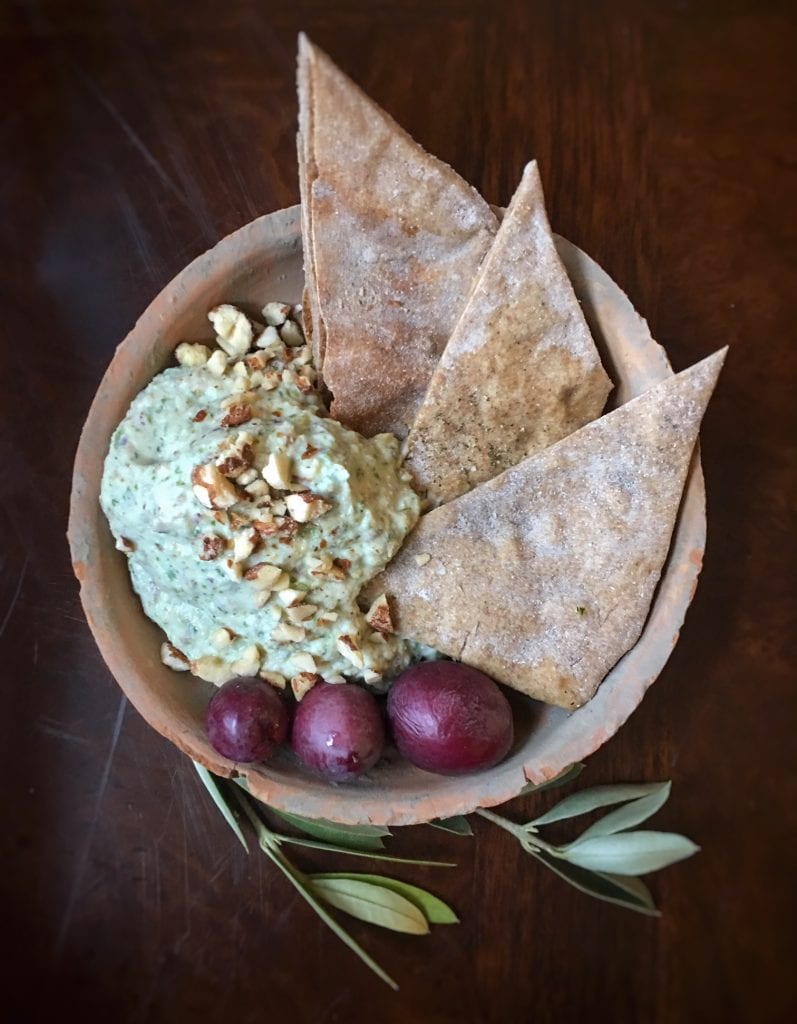Hello good readers and Happy New Year to you! Now that we’ve all spent two weeks trying to eat healthy again after the holidays, I trust that everyone is now ready to abandon all New Year’s dietary resolutions and join me for some high-calorie Roman comfort food?…. Good! Because it’s ‘Moretum Week’ here at Tavola Mediterranea. That’s right. Who needs ‘Shark Week’ when you can be inundated by Roman cheese recipes instead, right?! So put down that bowl of kale and come with me, good people. We’re going to explore a calorie-rich Roman cheese ‘salad’ instead and not just one recipe for it, but three. This is our final recipe for ‘Moretum Week’. If you’d like to try the others, you can find them here! Before we dive in to this final recipe for moretum, let’s have bit of history first…

So, what is Moretum? The word ‘moretum’ roughly translates to ‘salad’ in latin and the dish is represented in the Roman written record, in the Late Republican and Early Imperial periods, as being a simple, vegetarian meal that is made with a base of cheese, additions of herbs and other greens, and condiments like olive oil or vinegar. Moretum is made using a common kitchen implement found throughout the Classical Mediterranean: a mortarium, or a mortar. The ingredients are added into the mortar, one by one, pulverized and minced together with a pestle, and formed into a spread or a dip which can then be consumed with bread.
Mortars were a commonly used kitchen implement in the Classical Mediterranean. They are common in the archaeological record the world over, actually, often found in the form of permanently installed grinding stones, inset floor basins, or free-standing stone or ceramic bowls. Mortars and pestles have been present in the archaeological record since the Paleolithic Period. They were typically formed from stone or ceramic that contained coarse inclusions in the clay, such as pumice or sand, which allowed for a porous working surface with which to grind or pulverize foodstuffs and medicinals. A pestle was used to pound or pulverize ingredients against the porous inner surface of the mortar making these implements the world’s first food processors and highly efficient ones at that. Mortaria, the Roman mortar, were common in Roman kitchens and were used daily for food preparation. Making moretum was just one of the uses for the Roman mortarium.

There are several references to moretum in the Classical Roman documentary record: one from a poem in the Appendix Vergiliana (we’ll get to that, don’t worry…); and a few more from the agricultural writings of Columella (4 BC-70 AD). This post’s moretum recipe comes from our good friend Columella and his aforementioned writings entitled De Re Rustica (On Agriculture) written in circa 60/65 AD. It’s a nice place to finish on the moretum scale of complexity as this recipe is an augmented version of Columella’s basic moretum recipe that was published as a part of ‘Moretum Week’ on Tavola. It’s mild, creamy and the herbs give it a fresh, summery flavour. The almonds top it all of with a warm, nutty flavour and a slightly crunchy texture.
So who is Columella? Lucius Junius Moderatus Columella (4 BC-70 AD) was a respected Roman farmer and a writer who, like Cato, left a great deal of information in the documentary record about early Roman-era farming, agriculture and animal husbandry. Columella was a provincial Roman, born in Hispania Baetica (Spain), who also held farm estates in Italy. While he documented information on farm-management, Columella also provided a great deal of insight into pastoral food-preparation practices through basic recipes in his writings titled De Re Rustica (65 AD).
With that brief bit of history added into the mix, let us roll up our sleeves and prepare our moretum.
Columella’s Fresh Cheese Moretum with Almonds
Ingredients
- 1 lb (450 gr) of fresh ricotta (goat’s or cow’s milk)
- ½ tsp dried mint (or 10 leaves if fresh)
- ½ tsp dried coriander (or 10 leaves if fresh)
- ½ tsp dried savory (or 10 leaves if fresh)
- 1 tsp dried or a few sprigs of fresh thyme (remove twigs)
- A few leaves of edible rue (or a handful of cicoria/dandelion greens)
- Handful of fresh parsley
- 2 chives or green onions
- Handful of curly endive leaves/tops
- Handful of arugula (rocket)
- Fresh cracked pepper
- Salt to taste
- Olive oil
- 1 cup of almonds
- 1 tbsp white wine vinegar
Implements
- A mortar and pestle or a mortarium if you’re fortunate enough to have one!
Preparation
In his writings, De Re Rustica (60/65 AD), Columella tells us to prepare Moretum like so:
De Re Rustica, Book XII, LIX: “Quemadmodum Moretum Facias: Addito in mortarium satureiam, mentam, rutam, coriandrum, apium, porrum sectivum aut, si id non erit, viridem cepam, folia lactucae, folia erucae, thymum viride, [vel] nepetam, tum etiam viride puleium et caseum recent<em> et salsum. Ea omnia pariter conterito acetique piperati exiguum permisceto; hanc mixturam cum in catillo composueris, oleum superfundito.” et “Caseum Gallicum vel cuiuscumque notae volueris minutatim concidito et conterito nucleosque pineos, si eorum copia fuerit, si minus, nuces avellanas torrefactas, adempta cute, vel amygdalas e<a>que, <quae> supra, condimenta pariter misceto acetique piperati exiguum adicito et permisceto compositumque oleo superfundito.”
From this passage we can read the following when translated into English:
“Put into a mortar savory, mint, rue, coriander, parsley, chives or green onion, leaves of lettuce, rocket, thyme and catmint, and fresh (new) cheese and salt. Mix thoroughly and mix in a little pepper. All these measures were ground in a like manner; this mixture is served with a little oil on the top.” He then adds that pine nuts or nuts and vinegar can be added to the base recipe to make a different style of moretum: “Break up the (Gallic) cheese into little pieces, chop and pound pine nuts into it, if you have plenty of them, if not, toasted hazelnuts removed from their shells or almonds out of the skin can be added to the above compound with the same seasonings. Mix them with the oil and mix in a little peppered vinegar and mix thoroughly on the top.”
From: The Latin Library
Here’s how I interpreted Columella’s recipe:

1.To begin, we want to get all of our ingredients trimmed, washed and ready. If you would like to make your own fresh cheese you can try one of these two recipes: Homemade ricotta using lemon, or Columella’s cheese made using fig rennet. Try this if you can as the consistency of the cheese is drier and denser. You can also buy a tub of ricotta, fresh goat cheese, or feta to use in this recipe although I would use feta as a last resort as Columella specifies fresh (recentem) cheese not aged, salted or brined cheese. If you do not have a mortar and pestle, do not fret. They can be found at every cooking supply shop nowadays and can also be ordered online at Amazon. You can opt to use a mixer to make this recipe but you’ll miss out on all of the fun and the general understanding of the labour and ancient food preparation technology involved in this recipe if you do.
2. I am using a modern household mortar for my recipe as I do not have a larger mortarium bowl. Given that the receptacle of most modern mortars are quite small it’s best to work with the ingredients in batches. Once the mortar is full, dump the pulverized herbs in a bowl on the side and keep going. Start processing all of your herbs and greens by loading the bowl of the mortar to capacity. Press your pestle into the herbs/greens and mince them by moving the pestle in a circular motion around the inner edge of the mortar. You’ll be shocked as to how much you can reduce the greens and herbs in a very short amount of time. See the video below as an example.
3. Once you’ve reduced all of your herbs and greens, you’ll want to add in the cheese, vinegar, salt and pepper. You can mix everything together in a large bowl or in the mortar bowl if you are using one with a larger basin. Mix the cheese, salt and pepper in to suit your tastes as I am sure our friend Columella did as well. Free free to use some or all of the cheese called for in this recipe. Texture can be thick or creamy; I prefer mine to be on the thicker side so I can scoop it up with flatbread.

4. Once you’ve achieved the texture that you like, transfer the moretum into a serving bowl. Fill the mortar with the almonds now and pulverize them as best as you can. Add 3/4 of the cup of almonds into the moretum mix and then dust the top with the remainer of the almond pieces. Drizzle the moretum with some peppery, fresh olive oil. Note: I piped my moretum into the serving bowl for clean presentation. Serve with fresh-baked Panis Quadratus, Tracta or Ploughman’s Flatbread and enjoy!
This recipe is easy enough to complete but the process itself was very interesting to me. It did not go unnoticed how quickly and efficiently the rotary motion of the pestle inside the mortar could reduce the herbs and greens completely in a very short time. It made me question several times why we waste electricity running our modern food processors when the old-school technique is just as effective! The texture and taste was delightful as well.
What stood out for me the most in tasting my first attempt at Columella’s basic Moretum recipe is how fresh and summery the flavours were. This recipe is simple but the flavours are bold and bright. The mint is very pleasant in the mix and the olive oil (I used a punchy, peppery Sicilian DOP) seems to open everything up a bit more and lend an overall peppery flavour to everything. The best part of this recipe is, however, the warmth and texture of the smashed almonds mixed in with the cheese; it’s very comforting, pleasing and filling. Coupled with fresh baked bread, it is easy to understand why Moretum was a favoured and regular Roman meal. So much so that Columella decided to document how to make it. And I’m grateful that he did!
Cena bene and happy pulverizing to you!

Did you try this recipe at home? If so, please feel free to leave comments or suggestions below. You can also join the conversation and share photos on the Tavola Mediterranea Facebook page or Instagram page.








